He had killed a sambhar stag the previous night. Sambhar are plagued by horseflies and their defence against them is to roll in the mud which when it dries off, makes a very effective shield against the biting insects. This part of the forest, in Ranthambore, has a river flowing over a very rocky bed. Flowing is what it does in the monsoon but for most of the year, it trickles and eventually all that are left are isolated pools, in particularly shady spots.
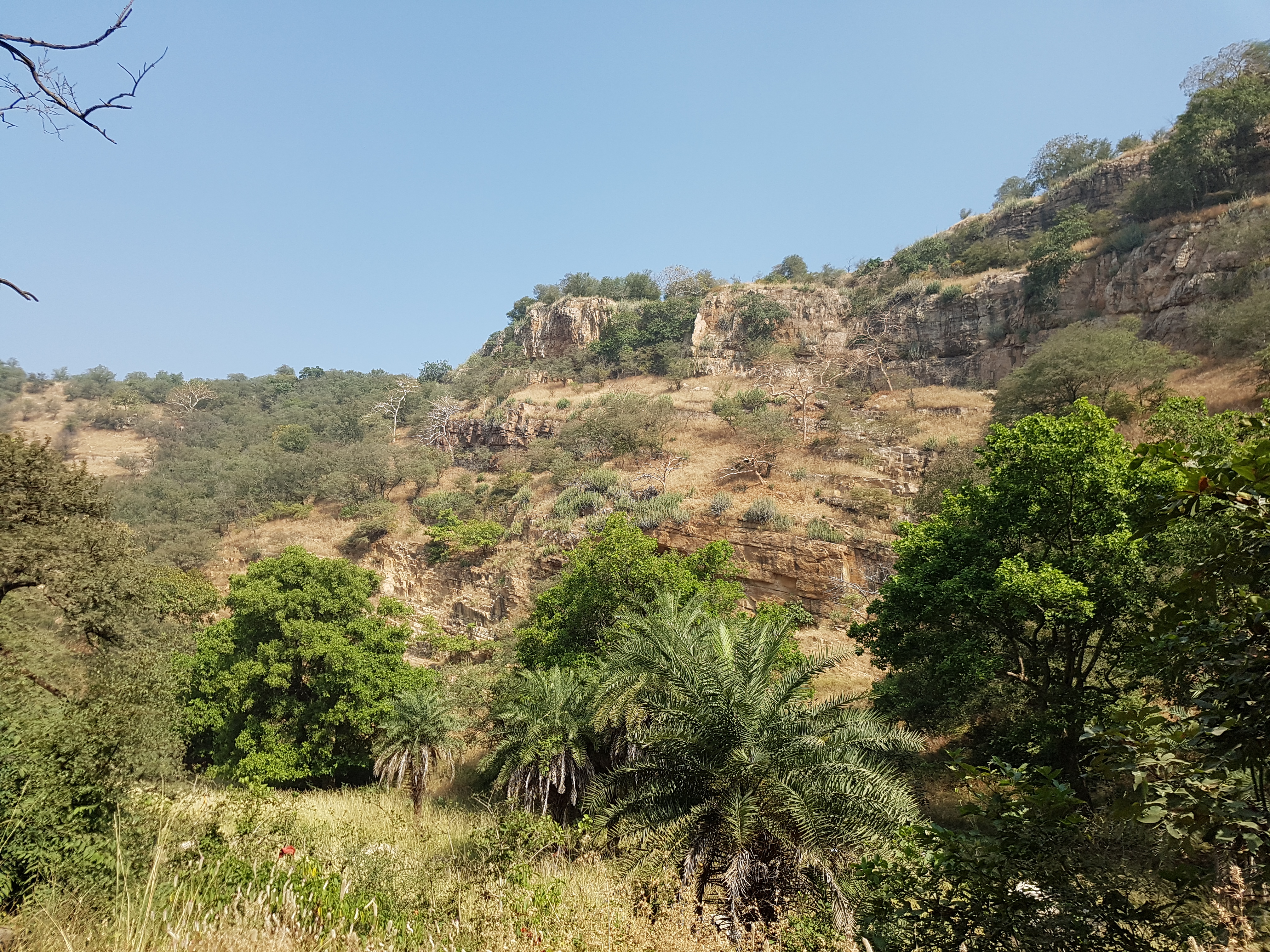 Ranthambore topography strikes you for three reasons; and high rocky hills, large number of Banyan trees (Ficus Bengalensis), and a sprinkling of temples, and domed pavilions just sitting in the middle of nowhere. This creates a unique ecosystem unlike in any other national park that I have seen, where thanks to the high rocky hills, animals can simply go away from vehicle tracks if they want to get away from people. People, the less said about whom, the better. More on this later.
Ranthambore topography strikes you for three reasons; and high rocky hills, large number of Banyan trees (Ficus Bengalensis), and a sprinkling of temples, and domed pavilions just sitting in the middle of nowhere. This creates a unique ecosystem unlike in any other national park that I have seen, where thanks to the high rocky hills, animals can simply go away from vehicle tracks if they want to get away from people. People, the less said about whom, the better. More on this later.
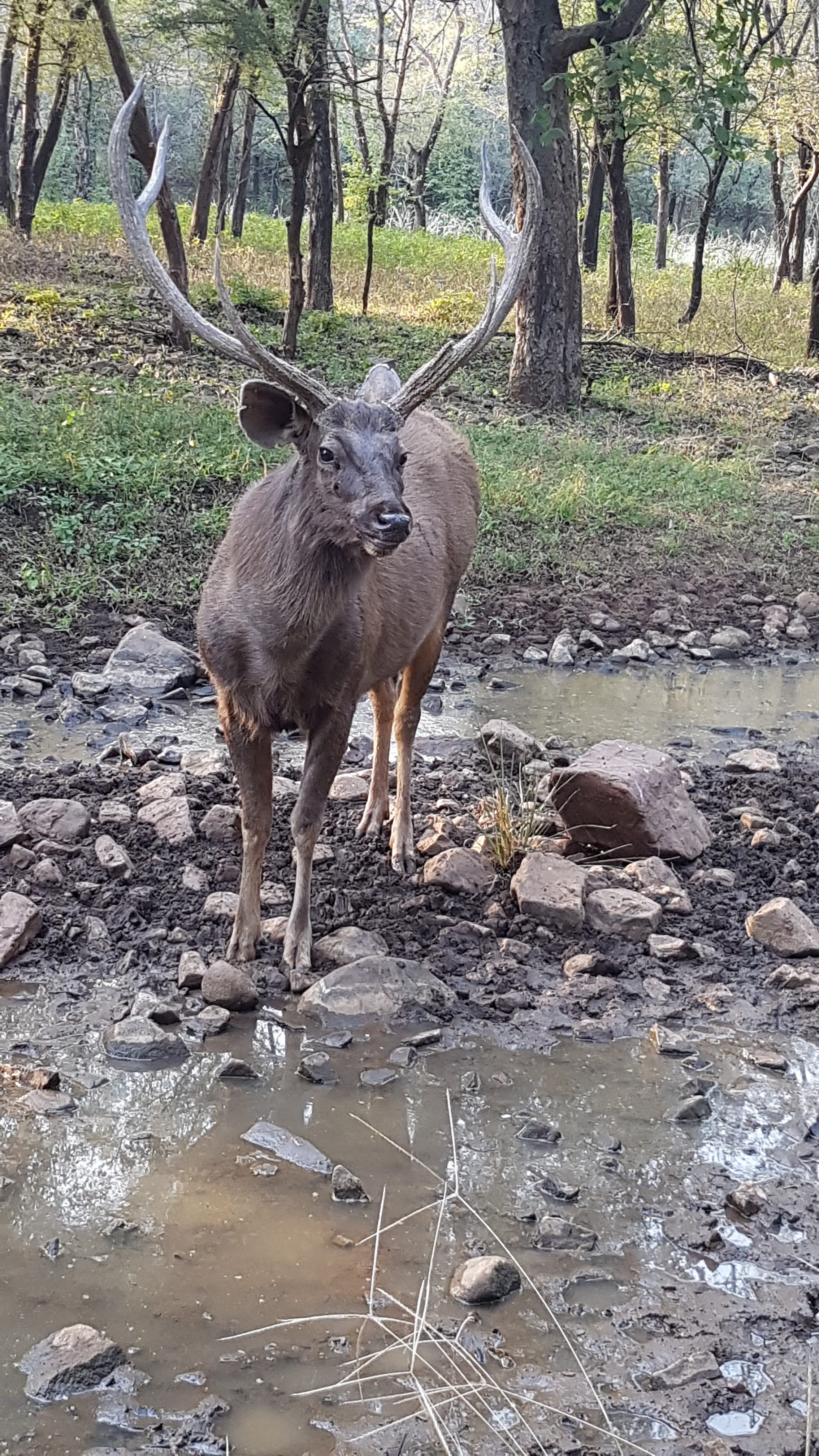 To return to our story, the stag came to the depression in the riverbed which was on its way to drying out totally but was still wet enough to have enough mud to make a very nice mud bath. The pool had not dried out as it was shaded by two massive banyan trees whose aerial roots had descended to the earth and created their own columns until it was almost impossible to decide which the original trunk of the tree was. The result was thick shade in which you were a few degrees cooler even in the hottest part of the day. Sunlight never struck the water directly and though the overall dryness of the atmosphere would eventually evaporate the water and dry out the pool, that was still some months away.
To return to our story, the stag came to the depression in the riverbed which was on its way to drying out totally but was still wet enough to have enough mud to make a very nice mud bath. The pool had not dried out as it was shaded by two massive banyan trees whose aerial roots had descended to the earth and created their own columns until it was almost impossible to decide which the original trunk of the tree was. The result was thick shade in which you were a few degrees cooler even in the hottest part of the day. Sunlight never struck the water directly and though the overall dryness of the atmosphere would eventually evaporate the water and dry out the pool, that was still some months away.
The stag walked down the hillside very carefully, all senses alert. His excellent eyesight was somewhat impaired as darkness had fallen and though starlight was enough for him to see clearly in the open, when he entered the shade of the banyans, he was seriously handicapped. What kept him going was habit. He had done this all his life and grown from a small fawn to the size of a horse with a massive neck that supported a rack of horns. He was confident. Tonight, was just another night. The horseflies had been particularly irritating all day. To roll in the mud in daylight was simply too dangerous. So, he had waited until it was dark and then cautiously, very cautiously, he came down the hillside. One step at a time, all senses alert, listening, interpreting the sounds and then deciding to take another step. Sometimes he would freeze with one forefoot in the air, totally still like a statue carved in rock, while he listened and smelt the breeze rising up to him from the river at the foot of the hill. Only when he was sure that there was no danger, would he take another step down the hillside.
He knew Kumbha. They were the same age, 8 years old. As he had grown, many a time, he had seen Kumbha’s mother and her two cubs, lying in the water of the river in the summer. Tigers are the only cats that love water and spend a lot of time in it especially during the heat of the day in Rajasthan’s very hot summers. At that time, he was himself a fawn, skittish and given to dashing off at the smallest sound. That is what kept him alive and he grew big and strong. Sambhar live in family groups and fawns learn to survive from their mothers. His mother had been a good teacher. He remembered that where he was headed was Kumbha’s territory which he regularly marked by spraying urine on trees as well as rubbing his face on low hanging branches so that the facial glands left their excretion as a mark of his territorial boundary. This was for the benefit of other tigers, to attract breeding tigresses and to keep other males away. But these chemical messages were smelt and respected by everyone in the forest. Some his prey, some passersby, some competitors. Deer, leopards, tigers, hyenas and humans who could recognize the signs. The stag reached the bottom and entered the shade of the banyans, headed to the mud bath beneath them.
The shade hid from him his greatest fear, Kumbha. Kumbha was not close to him at the time. He knew that it would be far easier to kill the stag when it was down and rolling in the mud than when it was still on high alert, approaching the mud bath. He was lying some distance away in the riverbed, completely hidden by the rocks, his own dappled, striped camouflage making him invisible. His stillness was such that even if the stag looked at him directly, he would not see him unless the wind changed direction and he smelt the tiger scent. Tigers have a kill rate of about one in seven and so Kumbha was no stranger to things going wrong at the last minute thanks to an errant eddy of air, leading to the deer scenting him and escaping in an explosive burst of speed, adrenalin coursing through his veins. Live deer, hungry tiger.
Kumbha hadn’t eaten for four days. He was keen, light on his feet and very hungry. Spells of starvation followed by gorging on meat until he can eat no more, is the routine of the tiger and all carnivores. Kumbha was in his element, his cat eyes enabling him to see clearly in the dark. He watched intently, but occasionally he would look away for a second or two. It is my guess that this is because the intense look can be sensed by the one, we are looking at. We can see this even with people, who will turn around and look at you if you stare at them. Animals with senses that are far keener than ours can sense anyone looking at them much more easily. So Kumbha looked away from time to time, to allow the sambhar to approach within striking distance.
All this took far longer than it will take you to read this, but for the players, the stakes are the highest; life and death. Eventually the sambar reached the mud, looked around for a final time and stepped in, knelt and rolled over once. Kumbha took that opportunity to race ahead a few steps, moving over dry leaves and twigs without cracking a single one and then went to earth again. The sambar scrambled up, looked around again to ensure that he was safe and then went down again to roll on the other side. Kumbha was within range and charged with an earth-shattering roar that is designed to paralyze prey for the instant that the tiger needs to seize it. The sambar struggled up, but Kumbha’s shoulder hit him and then the tiger closed his jaws on his throat, at a bite force of 1000 psi, keeping well clear of his lashing hoofs and the horn rack on his head. One strike by either can disembowel the tiger or injure him permanently so that he eventually dies of starvation.
Once that sambhar was still, Kumbha started eating, starting from the rear soft underbelly of the animal, going for the stomach contents. This is where carnivores get their quota of trace elements and other things that their own pure protein and fat, keto, diet can’t give them. While he ate, he would insert his head inside the thorax of the carcass to reach the heart and lungs and emerge completely covered in blood. Not nice to watch but if you are a tiger, you don’t give a hoot for public opinion. Tigers can eat as much as one hundred pounds of meat at one sitting, and then starve for days after. Kumbha ate his fill. The sambhar was big and there was plenty more to eat. Daylight was approaching, and he had to hide his kill from scavengers, so he dragged it out of the river and across the road that ran alongside, up a slight slope on the other side deep into a thicket where it was completely hidden. Then he returned to the river to drink. Having drank his fill, he returned to lie by the kill to sleep off his dinner and guard the kill simply by his presence. As the sun climbed in the sky and the heat intensified, Kumbha arose and walked to a damp spot on the side of the road and lay down in it, the cool mud feeling good on his belly. Later he would go further to the river to drink some more and lie in the water until the evening. For the present, he was asleep by the road, shaded by the banyans, and that is where we met him.
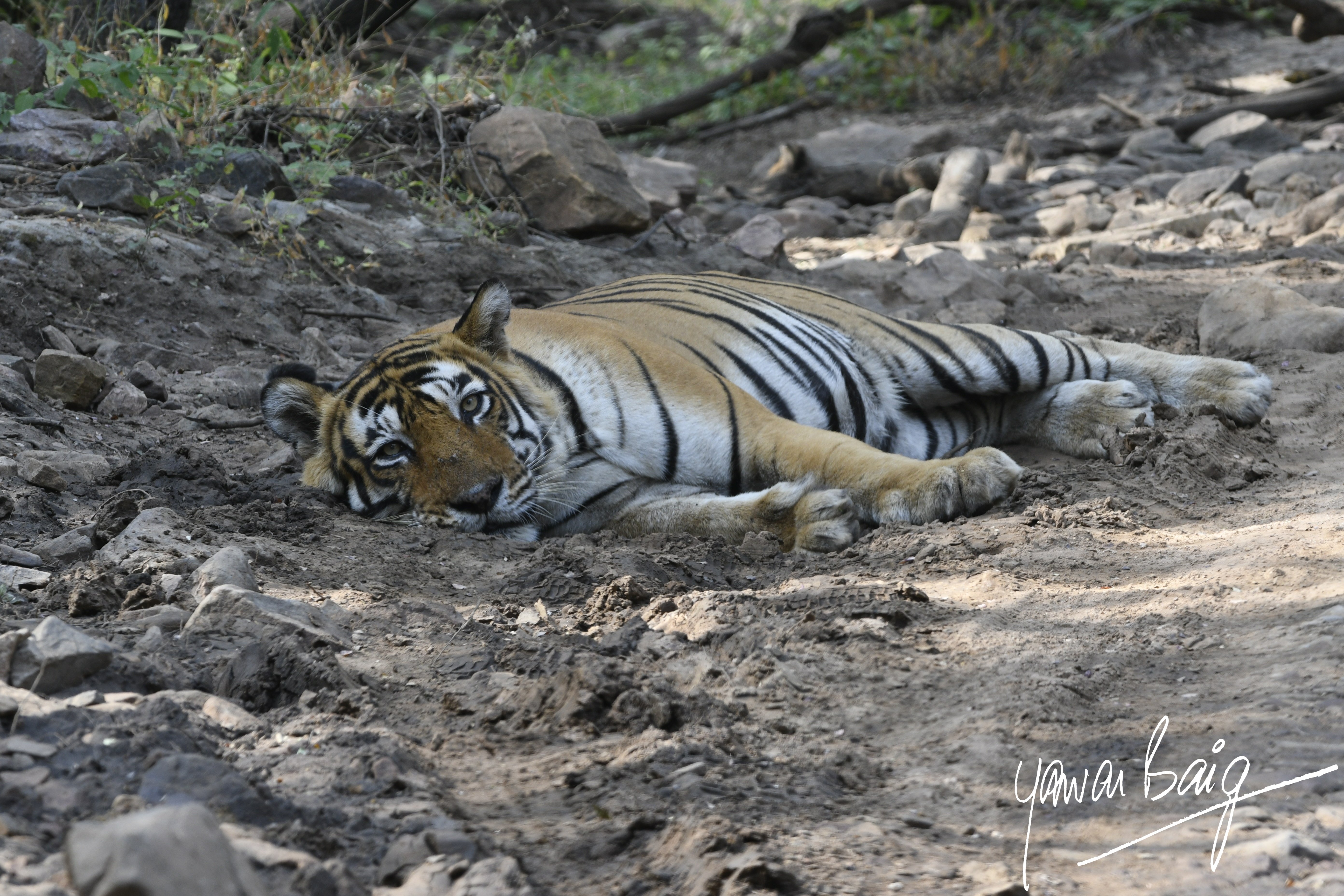
We were in Ranthambore almost at the end of our morning drive when we saw nine men, young and middle aged, standing on a culvert in various stages of undress. This was in the middle of the forest and I was astonished to say the least. I asked our guide and he said that there was a Solesar Mahdev mandir (temple) in the forest and these people had probably spent the night there and were returning to their village outside the national park. On the way they had decided to bathe in the river, evidence of which in the form of soap suds, soap packets strewn carelessly and their own state, bore witness. As we passed them, the Forest Guard who was our guide called out to them to get out of the forest immediately.
We drove perhaps less than a kilometer from there, on our way out of the forest, when we saw Kumbha lying by the roadside. We stopped in awe because a tiger in the forest is an awe-inspiring sight. It seems to light up the darkness and has a majesty that I find impossible to describe. An animal that can be five hundred pounds in weight with a head that seems to fill your vision to the exclusion of everything else, looking at you directly and unflinchingly with the yellowest eyes that you can imagine. His striped coat dappled in the sunlight filtering through the leaves, stained dark with blood around his face from the kill that he had been eating. Lying with the relaxed grace that only a cat can muster. Yet I know that to go from there to 60 mph in a flash if he decides to charge, is something that he can do without raising a sweat. We stopped a respectful distance from him and took our photographs. He raised an eyebrow to keep us in sight but didn’t move from his totally supine position. He knew that we didn’t represent danger, but he kept an eye on us.
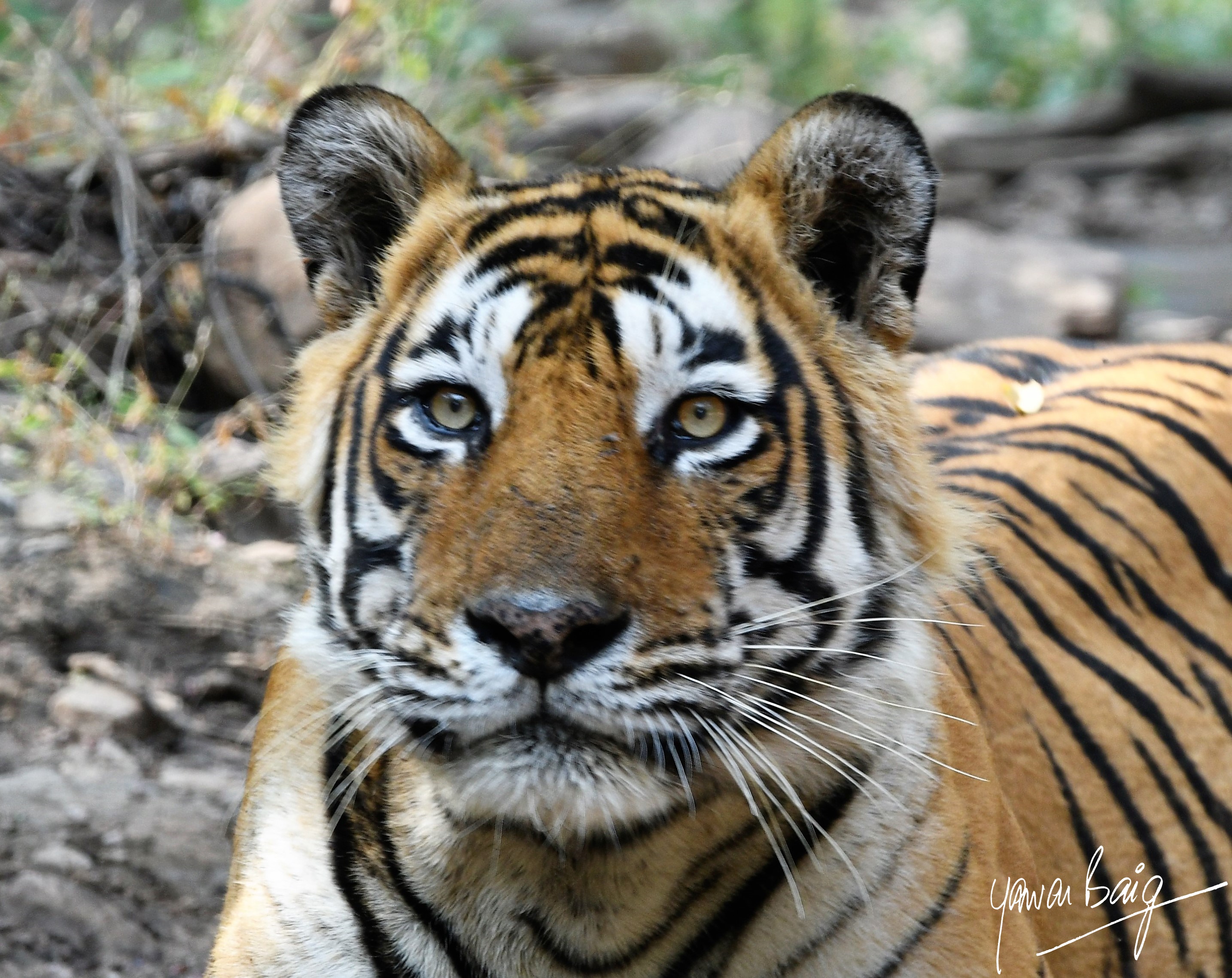 As we were photographing him suddenly it was as if he had stepped on an electric wire. He suddenly sat up and looked intently beyond us. I knew what he was sensing, though the temple devotees were not visible yet. Then he got up and walked up the slope to his kill and we lost sight of him. We remained where we were because we were concerned about the men. They came along, talking loudly among themselves, totally unaware that they were under surveillance. I have heard many people who know the jungle say that a tiger could be six feet away, but you wouldn’t know it. That day I saw how true this is. As the men came up to us, we told them about Kumbha. Their fright was amusing to put it politely. We then told them to walk on the other side of our vehicle so that the vehicle would be between them and the tiger until we were sure that any potential danger was past.
As we were photographing him suddenly it was as if he had stepped on an electric wire. He suddenly sat up and looked intently beyond us. I knew what he was sensing, though the temple devotees were not visible yet. Then he got up and walked up the slope to his kill and we lost sight of him. We remained where we were because we were concerned about the men. They came along, talking loudly among themselves, totally unaware that they were under surveillance. I have heard many people who know the jungle say that a tiger could be six feet away, but you wouldn’t know it. That day I saw how true this is. As the men came up to us, we told them about Kumbha. Their fright was amusing to put it politely. We then told them to walk on the other side of our vehicle so that the vehicle would be between them and the tiger until we were sure that any potential danger was past.
Human intervention in our national parks is a very serious problem in all parks. In some of them we have highways and train tracks running through the park paid for with the lives of animals crossing them. In others there are villages or temples which result in both pollution with paper and plastic as well as human-animal conflict which always has the same result. The animal is declared the villain and the punishment is death. In other cases, villages along national park boundaries constantly encroach on forest land by ring-barking trees so that in a few months they dry and fall and the area they covered becomes a part of the village fields. These fields are also protected by illegal electric fencing which electrocutes any animal trying to cross it. Many villagers lay out sticks of dynamite encased in rotting meat to attract wild boar which explode as soon as the boar bites into the meat. If the boar is lucky, his head is blown off and the people who set out the bomb, feast. If not, his jaw is blown away and he runs off into the forest to die an agonizing death, many hours or even days later. Sometimes, it is not a boar but a tiger, leopard or hyena that takes this bait with the same results. As I said earlier, human-animal conflict always has the same result.
The solution is a combination of relocation of human activity from inside the park to an alternate location, education of the public about the need for conservation of forests and wildlife, not merely for their entertainment but as a critical need for our own survival and law enforcement to ensure that forests and wildlife remain protected. In India we have reached a highly critical stage already and it is debatable if we have already gone over the edge as far as wildlife, especially tigers, are concerned. Be that as it may, what we must do is to focus on inculcating a sense of shared responsibility in all those who benefit from the forests, so that they learn to respect this great asset we have before it is gone forever.
To close with Kumbha’s story, what could have happened? Kumbha had eaten and in any case, humans are not tiger prey. So most probably nothing would have happened, and nobody would have been the wiser. But what is equally likely is that one of these people could have thrown a stone into the bushes and then who knows what would have happened?
Because there is a limit, even to the patience of a tiger.
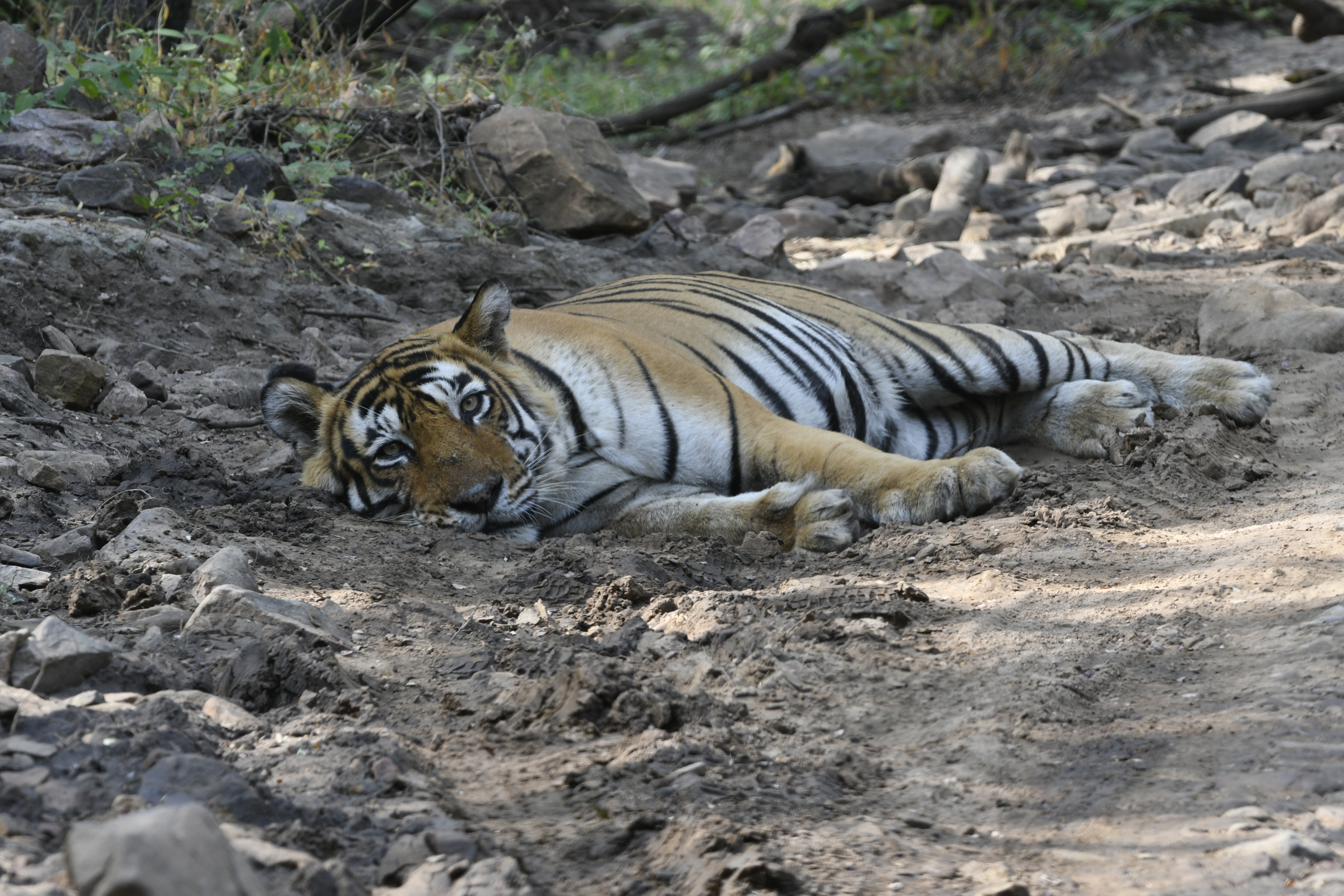
I want to go on a safari after reading that!!! Alhamdulilah another enjoyable read relating to wildlife and tigers, attention to detail is something I wish to learn from you!!
I too have witnessed how incredibly invisible a tiger can be, and also how forgiving. In Ranthambore while on a safari a lady, known to me, was desperate to relieve herself and we were forced to stop near a big bush, of approximately 10 feet in diameter. Even though getting off a vehicle in the park is not permitted, she was past caring, and there were no other vehicles around. The halt wouldn’t be for more then a minute or two. As the lady went behind the bush, from one side a tiger walked out from the other end and… Read more »
Wow… That would have facilitated her bowel movement boundlessly. The tiger is truly unique.
A very enjoyable read. Thanks